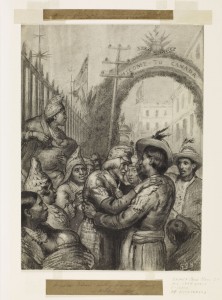11.5 Aboriginal-Newcomer Relations since Confederation
Jennifer Pettit, Department of Humanities, Mount Royal University

Additional attention to Canadian policy for Indigenous peoples came about as the result of Canadian Confederation in 1867. Section 91, Subsection 24 of the British North America Act made the federal government responsible for all matters related to Indigenous peoples, and made First Nations peoples into wards of the Federal Government. The portfolio of Indian Affairs was placed under the guidance of the Secretary of State and, despite some early failures, much of the earlier legislation and policies were maintained including the civilization plan, treaties, and the reserve system. Additionally, some new legislation was passed including the Enfranchisement Act (1869), which made enfranchisement compulsory in some cases (such as when an Indigenous woman married a non-Indigenous man), promoted individual land ownership, and granted the government the power to impose an elective band council system of governance. As had been the case in the past, these changes were made largely to benefit non-Indigenous society without consultation with First Nations peoples. The government was concerned with the territorial growth of Canada; acquiring land from the Hudson’s Bay Company in the West; creating the new provinces of Manitoba, British Columbia and Prince Edward Island; and creating an Indian Lands Branch in the new Department of the Interior in 1873.
“Christianize and Civilize”
The most significant piece of legislation in this period was the passage of the Indian Act of 1876.[1] Consisting of 100 sections, the Indian Act consolidated earlier legislation and addressed a wide variety of areas concerning lands, status, and governance. At the core of the Act was the reinforcement of the policy of aggressive assimilation and colonization. This Act, among other things, defined who was and was not an “Indian” according to the government, described band election procedures, defined a band and reserve, and discussed the management of resources including timber and band monies. Invasive and paternalistic, the Indian Act ignored the diversity among Indigenous groups in Canada, and treated Indigenous peoples as children who required management. Made into wards of the state, Indigenous peoples were no longer autonomous according to the government. As was the case in the past, central to the Indian Act and new policies was the plan to separate Indigenous peoples from their land through a system of treaty-making and reserves, and increased farming instruction and schools for Indigenous children. This plan was particularly important in Western Canada to clear the way for settlers who were central to Prime Minister John A. Macdonald’s National Policy, one part of which was the settlement of the West through immigration (see Section 3.3). However, first, the government had to extinguish Indigenous title through a series of treaties signed in the early and mid-1870s.
Given the changes brought about by the numbered treaties and the expanding importance of the Indian Affairs portfolio, in 1880, the Indian Branch of the Department of the Interior was turned into a separate department called the Department of Indian Affairs, although the Minister of the Interior continued to act as Superintendent-General of Indian Affairs and oversaw the new department. There would be much to focus on, including strengthening the civilization program through the promotion of farming instruction and schools.
Key Points
- In 1867, the Dominion of Canada inherited Britain’s responsibility for maintaining relations and honouring agreements made with Aboriginal peoples.
- Between the years 1867 and 1900, the policy of “civilization” continued, to which was added a greater focus on Christianization.
- The Indian Act (1876) took a “pan-Indian” view of Native peoples and created categories and processes that were both artificial and bureaucratic, which provided the means for aggressive colonization and displacement.
Attributions
Figure 11.6
Micmac Indians Waiting to Receive Lord Lorne, Halifax (Online MIKAN no.2839092) by Library and Archives Canada, Acc. No. 1984-45-1 is in the public domain.
- See John Leslie, The Historical Development of the Indian Act (Ottawa, ON: Treaties and Historical Research Centre, 1978). ↵

